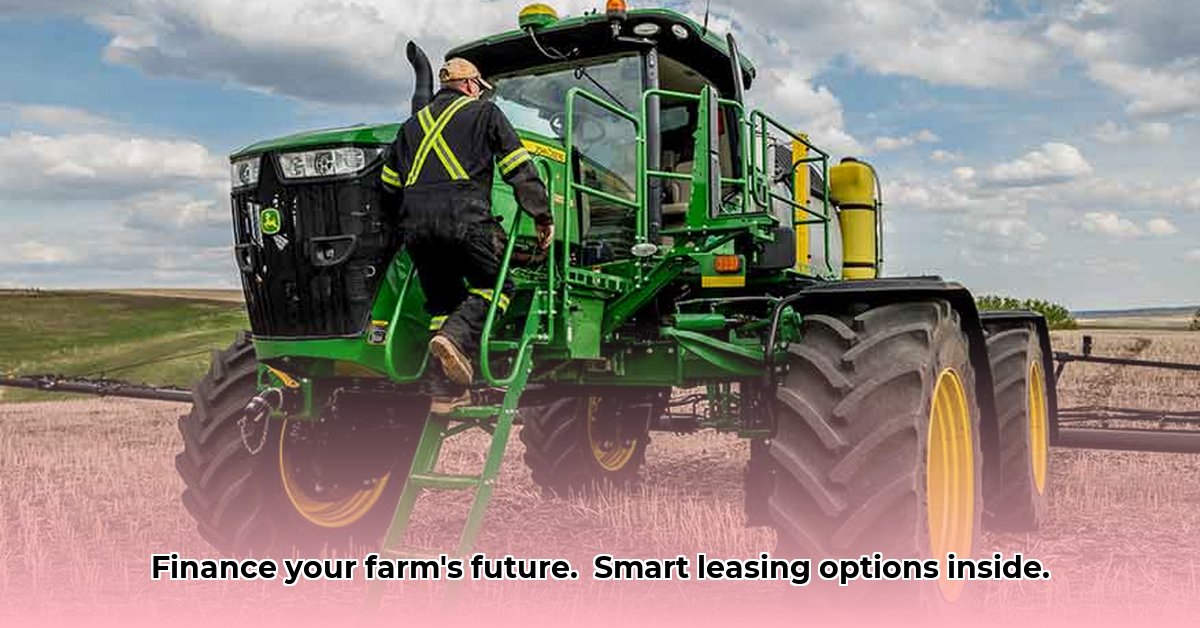
Getting the right financing for a tractor is crucial for the success of your farm. This comprehensive guide helps you navigate the complexities of tractor financing, whether you're a small-scale or large-scale operation. We'll delve into leasing versus loans, explore government incentives, and outline actionable steps to secure the best financing for your needs. For more detailed information on tractor loans, check out this helpful resource: Tractor Loan Options.
Leasing vs. Loans: A Comparative Analysis
Choosing between leasing and financing your tractor involves weighing several factors. Both options present distinct advantages and disadvantages.
Leasing a Tractor:
Pros:
- Lower upfront costs: Requires a smaller down payment, easing initial financial strain.
- Predictable monthly payments: Simplifies budgeting with consistent monthly expenses.
- Access to newer technology: Allows for upgrades to the latest, potentially more efficient models at the end of the lease term.
Cons:
- Higher total cost over time: Typically results in greater overall expenditure compared to purchasing.
- No ownership at the end: You don't own the tractor after the lease period concludes.
- Potential use restrictions: Lease agreements may impose limitations on how you use the equipment.
Financing a Tractor (Loan):
Pros:
- Ownership after repayment: You own the tractor once the loan is fully repaid.
- Potential tax benefits: Loan interest may be tax-deductible (consult a tax advisor).
- Potentially lower long-term cost: Can be cheaper than leasing over the tractor's lifetime, provided you manage your finances effectively.
Cons:
- Higher upfront costs: Demands a larger down payment and potentially higher monthly payments.
- Larger monthly payments: Monthly payments are generally higher than with a lease.
- Depreciation: Tractors depreciate in value over time, impacting your asset value.
Isn't it interesting that while leasing offers immediate accessibility, loans offer long-term ownership? Which option aligns better with your long-term financial goals?
Sustainable Farming and Tractor Financing
Sustainable farming practices, such as precision agriculture, often necessitate specialized equipment, influencing your financing decisions. These practices can lead to both higher upfront costs and potential long-term savings.
- Fuel Efficiency: Fuel-efficient tractors lower operational costs. How much could you save annually with a fuel-efficient model? This could significantly impact your return on investment.
- Reduced Tillage: No-till farming equipment, while initially more expensive, often yields long-term savings through reduced fuel, labor, and soil health management costs.
- Government Incentives: Many governments offer incentives to promote sustainable farming practices, potentially offsetting the higher upfront costs of sustainable equipment. This is a vital point to factor into the equation before committing to a financing choice for your tractor.
Government Programs and Subsidies
Government support can significantly influence your ability to finance a tractor. Various regional and national programs offer financial assistance for sustainable agricultural practices. These often include:
- Subsidies: Direct payments to help cover equipment costs.
- Tax Credits: Reductions in your tax bill, providing more funds for tractor purchases.
- Grants: Funding for initiatives focused on sustainable farming.
Regularly checking for updates on these programs is crucial, as eligibility criteria and application processes can change.
Managing Risk: A Proactive Approach
Purchasing a tractor is a substantial investment. Effective risk management is essential:
- Market Fluctuations: Diversify crops or livestock to mitigate risks associated with fluctuating farm income.
- Technological Advancements: Choose adaptable equipment that can be upgraded to future technology.
- Unexpected Repairs: Allocate funds for unforeseen maintenance and repairs in your budget.
How crucial is diversification to secure your farm’s financial health when considering a substantial investment in farm equipment? It’s worth a closer look.
Actionable Steps: A Practical Guide
- Assess Your Needs: Determine the type and size of tractor that best suits your farm's size, soil type, and operations.
- Explore Financing Options: Compare offers from multiple lenders, considering interest rates, terms, and conditions.
- Research Government Incentives: Investigate all available subsidies, tax credits, and grants.
- Develop a Financial Plan: Create a detailed budget encompassing tractor costs, operating expenses, and projected income.
- Secure Financing: Choose the financing option that best fits your carefully crafted financial plan and consult a financial advisor if needed. This should leave you feeling confidently prepared for the future financial health of your farm.
Remember, a well-structured financial plan is the cornerstone of successful tractor acquisition.
Tailoring Your Strategy: Small vs. Large-Scale Farms
Financing strategies vary considerably depending on farm size:
| Farmer Scale | Financing Strategy Suggestions |
|---|---|
| Small-Scale Farmer | Leasing might be more efficient; prioritize government grants and subsidies. |
| Large-Scale Farmer | Loans may be more suitable; explore bundling options and alternative financing like green bonds. |
By carefully weighing your options and implementing a robust financial plan, you can make well-informed decisions to ensure the long-term success of your farming operation. Consistent research into new financing models and government programs is vital for identifying the most effective solutions tailored to your unique circumstances.